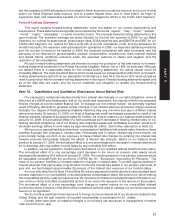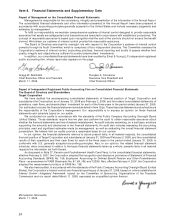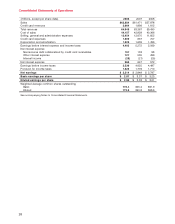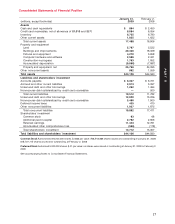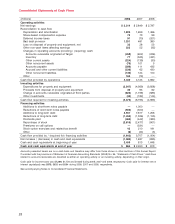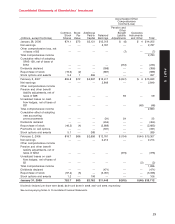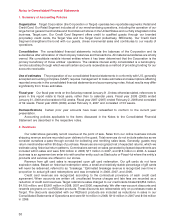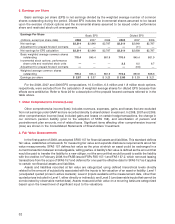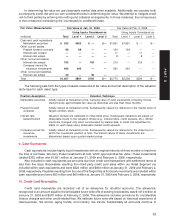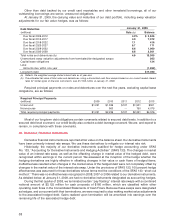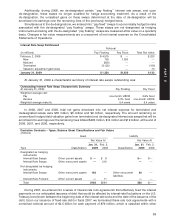Target 2008 Annual Report Download - page 52
Download and view the complete annual report
Please find page 52 of the 2008 Target annual report below. You can navigate through the pages in the report by either clicking on the pages listed below, or by using the keyword search tool below to find specific information within the annual report.
Basic earnings per share (EPS) is net earnings divided by the weighted average number of common
shares outstanding during the period. Diluted EPS includes the incremental shares assumed to be issued
upon the exercise of stock options and the incremental shares assumed to be issued under performance
share and restricted stock unit arrangements.
Earnings Per Share Basic EPS Diluted EPS
(millions, except per share data) 2008 2007 2006 2008 2007 2006
Net earnings $2,214 $2,849 $2,787 $2,214 $2,849 $2,787
Adjustment for prepaid forward contracts ————(11) —
Net earnings for EPS calculation $2,214 $2,849 $2,787 $2,214 $2,838 $2,787
Basic weighted average common shares
outstanding 770.4 845.4 861.9 770.4 845.4 861.9
Incremental stock options, performance
share units and restricted stock units ———3.2 6.0 6.7
Adjustment for prepaid forward contracts ————(0.6) —
Weighted average common shares
outstanding 770.4 845.4 861.9 773.6 850.8 868.6
Earnings per share $ 2.87 $ 3.37 $ 3.23 $ 2.86 $ 3.33 $ 3.21
For the 2008, 2007 and 2006 EPS computations, 10.5 million, 6.3 million and 1.8 million stock options,
respectively, were excluded from the calculation of weighted average shares for diluted EPS because their
effects were antidilutive. Refer to Note 26 for a description of the prepaid forward contracts referred to in the
table above.
Other comprehensive income/(loss) includes revenues, expenses, gains and losses that are excluded
from net earnings under GAAP and are recorded directly to shareholders’ investment. In 2008, 2007 and 2006,
other comprehensive income/(loss) included gains and losses on certain hedge transactions, the change in
our minimum pension liability (prior to the adoption of SFAS 158), and amortization of pension and
postretirement plan amounts, net of related taxes. Significant items affecting other comprehensive income/
(loss) are shown in the Consolidated Statements of Shareholders’ Investment.
In the first quarter of 2008, we adopted SFAS 157 for financial assets and liabilities. This standard defines
fair value, establishes a framework for measuring fair value and expands disclosure requirements about fair
value measurements. SFAS 157 defines fair value as the price at which an asset could be exchanged in a
current transaction between knowledgeable, willing parties. A liability’s fair value is defined as the amount that
would be paid to transfer the liability to a new obligor, not the amount that would be paid to settle the liability
with the creditor. In February 2008, the FASB issued FSPs FAS 157-1 and FAS 157-2, which removed leasing
transactions from the scope of SFAS 157 and deferred for one year the effective date for SFAS 157 as it applies
to certain nonfinancial assets and liabilities.
Assets and liabilities recorded at fair value are categorized using defined hierarchical levels directly
related to the amount of subjectivity associated with the inputs to fair valuation of an asset or liability: Level 1
(unadjusted quoted prices in active markets); Level 2 (inputs available at the measurement date, other than
quoted prices included in Level 1, either directly or indirectly); and Level 3 (unobservable inputs that cannot be
corroborated by observable market data). Assets measured at fair value on a recurring basis are categorized
based upon the lowest level of significant input to the valuations.
32
6. Earnings per Share
7. Other Comprehensive Income/(Loss)
8. Fair Value Measurements



